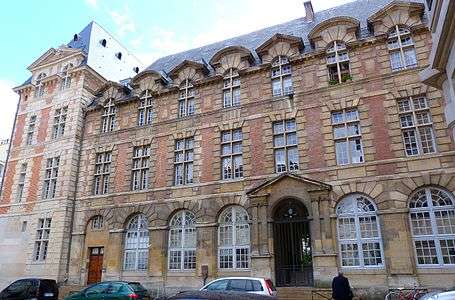Rue de l'Abbaye
 | |
| Length | 180 m (590 ft) |
|---|---|
| Width | 7.80 m (25.6 ft) between rue de l'Echaudé and rue Cardinale; 9.74 m for the remaining |
| Arrondissement | 6th |
| Quarter | Saint-Germain-des-Prés |
| From | 18 rue de l'Echaudé |
| To | 1 place Saint-Germain des Prés and 37 rue Bonaparte |
| Construction | |
| Completion | c. 18th century |
Rue de l'Abbaye is a commercial street in the 6th arrondissement of Paris, named after the Abbey of Saint-Germain-des-Prés. It has a length of some 170m and runs from the Rue Guillaume Apollinaire to the Rue de l'Echaudé. The street itself dates from 1800 although the land it runs over has a much longer history.
Transportation
The area is served by the following stations of the Paris Métro:
- Saint-Germain-des-Prés (approx. 90 m from the westernmost end of the street)
- Mabillon (approx. 100 m from the easternmost end of the street).
History
The Benedictine abbey was founded by Childebert, son of Clovis, in 543 to house relics brought from the siege of Saragossa the previous year. These included the tunic of Saint-Vincent and a cross of gold from Toledo; in consequence, the church and abbey were originally known as Saint-Vincent and Sainte-Croix. The church was founded somewhat later in 557 by Germain, Bishop of Paris, who was buried there in 576. A small market town grew up around the religious centre which became a place of pilgrimage and whose name changed to Saint-Germain-des-Prés ("of the meadows") in the 9th century. The Merovingian kings of France were also buried here — the tombs all disappearing during the French Revolution.
Around 1000 a new Romanesque church with three bell towers was built. Two of these were knocked down in 1821 due to their state of decomposition from the saltpetre in the gunpowder stored there during the French Revolution. The third bell tower still remains.
The abbot's palace (Palais Abbatial), commissioned by Charles de Bourbon in 1586, is still occupied (Nos 1-5). The abbot's garden also exists to this day and was the scene of one of the most sombre episodes of the French Revolution, the September Massacres of the 2nd to 5 September 1792.
The street was built in 1800 by driving a way through the abbey grounds which had been taken over by the new Republic. The old refectory and part of the chapel were destroyed in the creation of the street which was initially known as rue de la Paix, became rue Neuve de l'Abbaye in 1809 and settled on its current name in 1815. As recently as 1951, that portion of the original street between Rue Bonaparte and Rue Saint-Benoît was renamed Rue Guillaume Apollinaire after the poet Guillaume Apollinaire.
Composition

- The abbot's palace was built by Charles de Bourbon in 1586. It is the second building in Paris built of brick and stone. It now belongs to the Catholic Institut of Paris. [1] This building has also, over the years, housed a number of well-known artists, such as Jean Francois Gigoux, and Jean-Jacques Pradier.
- The tomb of René Descartes is currently in the church of Saint Germain-des-Prés.
- Le Petit Zinc cafe is on the corner of Rue Saint Benoit and what was Rue de l'Abbaye (now Rue Guillaume Apollinaire). Its facade is a notable example of the Art Nouveau Guimard style, named from the architect Hector Guimard, which can also be seen in the 60 or so Métro entrances he designed.
- The Square Laurent-Prache was opened to the public in 1901. It was created on that part of the ruins of the abbey where the house of Alphonse Daudet had stood.
- A head of Dora Maar by Pablo Picasso, (started in 1918 and completed in 1941), as a memorial to his recently deceased friend Guillaume Apollinaire was installed in the Square Laurent-Prache on June 5, 1959 and has now been returned after a short sojourn in front of the Mairie d'Osny in the Val-de-Oise department. This statue was stolen during the night of 30-31 March 1999, resurfacing a month later as an 'objet d'art' at the Hôtel de Ville in Osny.
- The UPQ St Germain-des-Prés (Unité de Police de Quartier or local police unit) is at 14 rue de l'Abbaye.
References
- ↑ Hillairet, p 201-204

- Les bâtiments monastiques de l’abbaye de Saint-Germain-des-Prés, H. Verlet, in Paris et Île-de-France, Mémoires, IX, 1957-1958.
- Nouvelle Histoire de Paris, ed. Hachette, 21 volumes.
- Hillairet, Jacques. "Connaissance du Vieux Paris" (1956) p 201-204
External links
- Map of Paris (browser plugin required)
- For an aerial photograph tick Voie, adresse and type Abbaye
- Paintings by Leteurtre
- Head of Dora Marr
Coordinates: 48°51′15.2″N 2°20′5″E / 48.854222°N 2.33472°E